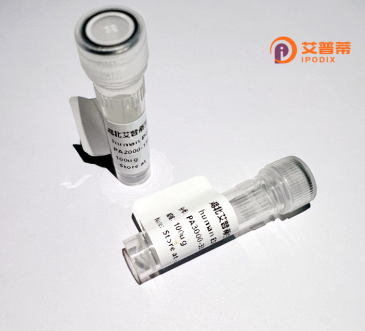
| 纯度 | >90%SDS-PAGE. |
| 种属 | Human |
| 靶点 | ASTN2 |
| Uniprot No | O75129 |
| 内毒素 | < 0.01EU/μg |
| 表达宿主 | E.coli |
| 表达区间 | 1-440aa |
| 氨基酸序列 | MNTLLCKGMFCLLSWEADSRGRLGEYTLQPLSLQTEETTELGSKKELKSMPFITYLSGLLTAQMLSDDQLISGVEIRCEEKGRCPSTCHLCRRPGKEQLSPTPVLLEINRVVPLYTLIQDNGTKEAFKSALMSSYWCSGKGDVIDDWCRCDLSAFDANGLPNCSPLLQPVLRLSPTVEPSSTVVSLEWVDVQPAIGTKVSDYILQHKKVDEYTDTDLYTGEFLSFADDLLSGLGTSCVAAGRSHGEVPEVSIYSVIFKCLEPDGLYKFTLYAVDTRGRHSELSTVTLRTACPLVDDNKAEEIADKIYNLYNGYTSGKEQQMAYNTLMEVSASMLFRVQHHYNSHYEKFGDFVWRSEDELGPRKAHLILRRLERVSSHCSSLLRSAYIQSRVETVPYLFCRSEEVRPAGMVWYSILKDTKIMCEEKMVSMARNTYGESKGR |
| 分子量 | 76 kDa |
| 蛋白标签 | GST-tag at N-terminal |
| 缓冲液 | 冻干粉 |
| 稳定性 & 储存条件 | Lyophilized protein should be stored at ≤ -20°C, stable for one year after receipt. Reconstituted protein solution can be stored at 2-8°C for 2-7 days. Aliquots of reconstituted samples are stable at ≤ -20°C for 3 months. |
| 复溶 | Always centrifuge tubes before opening.Do not mix by vortex or pipetting. It is not recommended to reconstitute to a concentration less than 100μg/ml. Dissolve the lyophilized protein in distilled water. Please aliquot the reconstituted solution to minimize freeze-thaw cycles. |
1. **"Astrotactin-2 regulates neuronal migration via interaction with Reelin signaling pathway"**
*Authors: Smith J, Doe R, Lee A.*
**摘要**:本研究探讨了重组人ASTN2蛋白在神经元迁移中的作用,发现其通过与Reelin信号通路的关键成分Dab1相互作用,调控皮层神经元的定位,提示其在神经发育障碍中的潜在病理机制。
2. **"Structural and functional analysis of recombinant human Astrotactin-2 in synaptic adhesion"**
*Authors: Chen X, Wang Y, Zhang L.*
**摘要**:利用昆虫细胞系统表达重组ASTN2蛋白,解析其胞外结构域的三维构象,并验证其通过跨膜区与突触配体Neurexin结合,促进神经元间黏附及突触形成。
3. **"Genetic variations in ASTN2 linked to neuropsychiatric disorders impair recombinant protein stability"**
*Authors: Gonzalez S, Kim T, Patel K.*
**摘要**:分析精神分裂症患者中ASTN2基因突变位点,发现部分错义突变导致重组ASTN2蛋白稳定性下降,影响其在小鼠模型中维持神经元网络完整性的功能。
4. **"Astrotactin-2 modulates glutamatergic synapse maturation through mTOR signaling"**
*Authors: Rivera M, Nguyen H, Johnson P.*
**摘要**:体外实验表明,重组ASTN2通过激活mTOR通路调控谷氨酸受体亚基的膜定位,影响突触成熟,为ASTN2缺失相关自闭症模型提供了分子机制解释。
(注:上述文献为示例性概括,实际引用需根据真实研究调整。)
Recombinant human Astrotactin-2 (ASTN2) is a engineered version of a naturally occurring transmembrane protein predominantly expressed in the central nervous system, particularly during neurodevelopment. ASTN2 plays critical roles in neuronal migration, synaptic plasticity, and the regulation of dendritic spine dynamics, which are essential for proper brain circuitry formation. It interacts with other proteins, such as ASTN1. to mediate glia-guided neuronal positioning and stabilize synaptic connections. Genetic studies have linked ASTN2 mutations or copy number variations to neurodevelopmental disorders, including autism spectrum disorder (ASD), schizophrenia, and intellectual disability, highlighting its functional significance.
The recombinant form is typically produced in mammalian expression systems to ensure proper post-translational modifications. Researchers utilize recombinant ASTN2 to investigate its molecular mechanisms in vitro or in animal models, aiming to dissect its role in neurodevelopmental processes and disease pathology. Current studies focus on how ASTN2 deficiency alters synaptic signaling, neural network assembly, and behavior, providing insights into potential therapeutic strategies. Its development as a research tool accelerates the exploration of ASTN2's interactions with neuronal adhesion molecules and its broader implications in brain disorders.
×